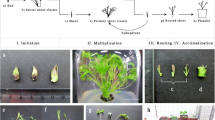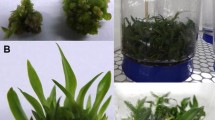Abstract
Within the family Araceae, Anthurium is the largest, most morphologically diverse and complex genus, consisting of approximately 1000 species. Native to Central and South America, members of Anthurium are found at elevations ranging from sea level to 3000 m, most commonly in cloud forests at 1500m (Croat 1986). Plants of this herbaceaous perennial monocot are terrestrial or epiphytic. Typical of the aroids is the spadix, consisting of a multitude of unobtrusive true flowers supported by a fleshy axil. The protogynous nature of the bisexual flowers in Anthurium favors cross-pollination. The commercial flower is a combination of the spadix and a colorful modified leaf, termed spathe. Attractive foliage of some species makes anthuriums also suitable for leaf harvest and cultivation as a potted plant.
Access this chapter
Tax calculation will be finalised at checkout
Purchases are for personal use only
Preview
Unable to display preview. Download preview PDF.
Similar content being viewed by others
References
Croat T (1986) The distribution of Anthurium (Araceae) in Mexico, Middle America and Panama. Selbyana 9: 94–99
Eapen S, Rao PS (1985) Regeneration of plants from callus cultures of Anthurium patulurn. Curr Sci 54: 284–286
Fernandez JA, Tanabe M, Crane S, Wolff W, Moriyasu P (1992) Anthurium in vitro triple indexing II. In: Delate KM, Tome CHM (eds) Proc 5th Hawaii Anthurium Industry Conf. Hawaii Institute of Tropical Agriculture and Human Resources, HITAHR 02.02.94, University of Hawaii, Honolulu, p 19
Finnie JF, van Staden J (1986) In vitro culture of Anthuurium andraeanum. S Afr J Bot 52: 343–346
Geier T (1982) Morphogenesis and plant regeneration from spadix fragments of Anthurium scherzerianum cultivated in vitro. In: Fujiwara A (ed) Plant tissue culture 1982 . Maruzen, Tokyo, pp 137–138
Geier T (1988) Ploidy variation in callus and regenerated plants of Anthurium scherzerianum Schott. Acta Hortic 226: 293–298
Geier T (1990) Anthurium. In: Ammirato PV, Evans DA, Sharp WR, Bajaj YPS (eds) Handbook of plant cell and tissue culture, vol 5. Ornamental species. McGraw-Hill, New York, pp 228–252
Hawaii Agricultural Statistics Service (1994) Hawaii flowers and nursery products, annual summary. Hawaii Dep Agric, US Dep Agric, Honolulu, Hawaii
Higaki T, Rasmussen HP (1979) Chemical induction of adventitious shoots in anthurium. HortScience 14: 64–65
Higaki T, Lichty JS, Moniz D (1994) Anthurium culture in Hawaii. HITAHR Research Extension Series 152, University of Hawaii, Honolulu
Imamura J, Higaki T (1981) Transfer of tissue-cultured anthurium plantlets from flask to natural conditions. Hortic Digest 61: 1–2
Imamura J, Higaki T (1988) Effect of GA3 and BA on lateral shoot production on Anthurium. HortScience 23: 353–354
International Floriculture Quarterly Report (1992) Cut flower 1991 rankings, vol 3. Pathfast Publishing, Essex, pp 56–62
International Floriculture Quarterly Report (1994) Cut flower and pot plant prices through the Dutch auctions, vol 4. Pathfast Publishing, Essex, pp 63, 77–78
Kuehnle AR, Nan GL (1991) Isolation and culture of protoplasts from two tropical monocots, Anthurium and Dendrobium orchid. Physiol Plant 82: A7
Kuehnle AR, Sugii N (1991) Callus induction and plantlet regeneration of Hawaiian anthuriums. HortScience 26: 919–921
Kuehnle AR, Sugii N (1992) Update on somatic embryogenesis research. In: Delate KM, Tome CHM (eds) Proc 5th Hawaii Anthurium Industry Conf. Hawaii Institute of Tropical Agriculture and Human Resources, HITAHR 02.02.94, University of Hawaii, Honolulu, pp 15–16
Kuehnle AR, Chen FC, Sugii N (1992a) Somatic embryogenesis and plant regeneration in Anthuurium andraeanum hybrids. Plant Cell Rep 11: 438–442
Kuehnle AR, Chen FC, Sugii N, Jaynes J, Norman D, Alvarez A (1992b) Engineering blight resistance in Anthurium: a progress report. In: Delate KM, Tome CHM (eds) Proc 5th Hawaii Anthurium Industry Conf. Hawaii Institute of Tropical Agriculture and Human Resources, HITAHR 02.02.94, University of Hawaii, Honolulu, pp 17–18
Kunisaki JT (1980) In vitro propagation of Anthurium andreanum Lind. HortScience 15: 508–509
Lightbourn GJ, Devi Prasad PV (1990) In vitro techniques for rapid multiplication of four varieties of Anthurium andraeanum in Jamaica. Proc Interam Soc Trop Hort 34: 3–5
Liu CM, Xu ZH (1992) An efficient procedure for micropropagation of Anthurium scherzerianum Schott (flamingo flower). Chin J Bot 4: 49–55
Madison M (1980) Aroid profile no. 6: Anthurium andreanum. Aroideana 3: 58–60
Maurer M, Brandes S (1979) Die Extraktion der Samen von Anthurium scherzerianum-Hybriden. Gartenbauwissenschaft 44: 71–73
Murashige T, Skoog F (1962) A revised medium for rapid growth and bioassays with tobacco tissue cultures. Physiol Plant 15: 473–497
Nitsch JP (1969) Experimental androgenesis in Nicotiana. Phytomorphology 19: 389–404
Norman D, Alvarez A (1994) Latent infections of in vitro anthurium caused by Xanthomonas campestris pv. dieffenbachiae. Plant Cell Tissue Organ Cult 39: 55–61
Pierik RLM (1991) Commercial micropropagation in Western Europe and Israel. In: Debergh PC, Zimmerman RH (eds) Micropropagation. Kluwer, Dordrecht, pp 155–165
Pierik RLM, Steegmans HHM, van der Meys JAJ (1974) Plantlet formation in callus tissues of Anthurium andraeanum Lind. Sci Hortic 2: 193–198
Rosario TL, Lapitan LA (1981) Callus and plantlet formation in Anthurium andraeanum Lind. Phillipp Agric 64: 197–202
Singh F, Sangama (1991) Micropropagation and plant conformity in Anthurium andraeanum. In: Prakash J, Pierik RLM (eds) Horticulture — new technologies and applications. Kluwer, Dordrecht, pp 201–204
Tanabe M (1991) In vitro plant acclimatization. In: Leonhardt K, Evans D, Halloran J (eds) Hawaii tropical cut flower industry conference: growing in the 90’s. Hawaii Institute of Tropical Agriculture and Human Resources, HITAHR Res Ext Series 124, University of Hawaii, Honolulu, pp 100–101
Tanabe M, Matsumoto T (1992) Anthurium explant surface disinfestation. In: Delate KM, Tome CHM (eds) Proc 5th Hawaii Anthurium Industry Conf. Hawaii Institute of Tropical Agriculture and Human Resources, HITAHR 02.02.94, University of Hawaii, Honolulu, pp 10–11
Tanabe M, Keolanui R, Campbell J (1989) Anthurium seed tissue culture. In: Fernandez JA, Nishijima WT (eds) Proc 2nd Anthurium Blight Conf. Hawaii Institute of Tropical Agriculture and Human Resources, HITAHR 03.10.89, University of Hawaii, Honolulu, pp 52–53
Tanabe M, Arakawa C, Matsumoto T, Tanaka R, English J (1991) Anthurium in vitro propagation. In: Alvarez AM, Deardorff DC, Wadsworth KB (eds) Proc 4th Hawaii Anthurium industry conf. Hawaii Institute of Tropical Agriculture and Human Resources, HITAHR 06.18.91, University of Hawaii, Honolulu, pp 4–6
Tanabe M, Fernandez J, Moriyasu P, Crane S, Wolff W, Liu RW (1992) Anthurium in vitro triple indexing. In: Delate KM, Tome CHM (eds) Proc 5th Hawaii Anthurium Industry Conf. Hawaii Institute of Tropical Agriculture and Human Resources, HITAHR 02.02.94, University of Hawaii, Honolulu, pp 8–9
van Doesburg J (1991) What it takes to be successful: promotion, an essential factor in marketing. In: Leonhardt K, Evans D, Halloran J (eds) Hawaii tropical cut flower industry conference: growing in the 90’s. Hawaii Institute of Tropical Agriculture and Human Resources, HITAHR Res Ext Series 124, University of Hawaii, Honolulu, pp 22–31
Warner J, Herrera J, Guevara E (1993) Morphogenesis in vitro de Anthurium cubense (Araceae). Rev Biol Trop 41: 455–460
Zens A, Zimmer K (1988) Development of new cultivars of Anthurium scherzerianum Schott through in vitro propagation III. In vitro regeneration from leaf explants of clones. Gartenbauwissenschaft 53: 170–173
Author information
Authors and Affiliations
Editor information
Editors and Affiliations
Rights and permissions
Copyright information
© 1997 Springer-Verlag Berlin Heidelberg
About this chapter
Cite this chapter
Matsumoto, T.K., Kuehnle, A.R. (1997). Micropropagation of Anthurium . In: Bajaj, Y.P.S. (eds) High-Tech and Micropropagation VI. Biotechnology in Agriculture and Forestry, vol 40. Springer, Berlin, Heidelberg. https://doi.org/10.1007/978-3-662-03354-8_2
Download citation
DOI: https://doi.org/10.1007/978-3-662-03354-8_2
Publisher Name: Springer, Berlin, Heidelberg
Print ISBN: 978-3-642-08270-2
Online ISBN: 978-3-662-03354-8
eBook Packages: Springer Book Archive




